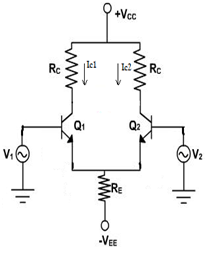11. Find collector current IC2, given input voltages are V1=2.078v & V2=2.06v and total current IQ=2.4mA. (Assume α=1)

A. 0.8mA
B. 1.6mA
C. 0.08mA
D. 0.16mA
12. A differential amplifier has a transistor with β0= 100, is biased at ICQ = 0.48mA. Determine the value of CMRR and ACM, if RE =7.89kΩ and RC = 5kΩ.
A. 49.54 db
B. 49.65 d
C. 49.77 db
D. 49.60 db
13. How is the arbitrary signal represented, that is applied to the input of the transistor? (Assume the common-mode signal and the differential mode signal to be VCM & VDM respectively).
A. Sum of VCM & VDM
B. Difference between VCM & VDM
C. Sum and Difference of VCM & VDM
D. None of the mentioned
14. How the differential mode gain is expressed using the ‘h’ parameter for a single-ended output?
A. – hfeRC/hie
B. 1/2 × (hfeRC./hie
C. – 1/2 × hfeRC
D. None of the mentioned
15. Find Common Mode Rejection Ration, given gm =16MΩ-1, RE=25kΩ
A. 58 db
B. 40 db
C. 63 db
D. 89 db
16. In a differential amplifier the input is given as
V1=30sinΠ(50t)+10sinΠ(25t) , V2=30sinΠ(50t)-10 sinΠ(25t), β0 =200,RE =1kΩ and RC = 15kΩ. Find the output voltages V01, V02 & gm=4MΩ-1
A. V01=-60[10 sinΠ(25t) ]-6.637[30sinΠ(50t) ], V02=60[10 sinΠ(25t) ]-6.637[30sinΠ(50t) ].
B. V01=-6.637[10 sinΠ(25t) ]-60[30sinΠ(50t) ], V02=6.637[10 sinΠ(25t) ]-60[30sinΠ(50t) ].
C. V01=-60[30 sinΠ(50t) ]-6.637[10sinΠ(25t) ], V02=60[30 sinΠ(50t) ]-6.637[10sinΠ(25t) ].
D. V01=-6.637[30 sinΠ(50t) ]-60[10sinΠ(25t) ], V02=6.637[30 sinΠ(50t) ]-60[10sinΠ(25t) ].
17. If the value of Common Mode Rejection Ratio and Common Mode Gain is 40db and -0.12 respectively, then determine the value of differential-mode gain
A. 0.036
B. -1.2
C. 4.8
D. 12
18. To increase the value of CMRR, which circuit is used to replace the emitter resistance Re in the differential amplifier?
A. Constant current bias
B. Resistor in parallel with Re
C. Resistor in series with Re
D. Diode in parallel with Re
19. What is the purpose of the diode in a differential amplifier with a constant current circuit?
A. Total current independent on temperature
B. Diode is dependent of temperature
C. Transistor is depend on temperature
D. None of the mentioned
20. How to improve CMRR value
A. Increase common-mode gain
B. Decrease common-mode gain
C. Increase Differential mode gain
D. Decrease differential mode gain
